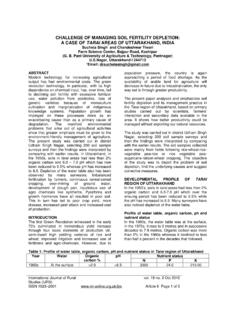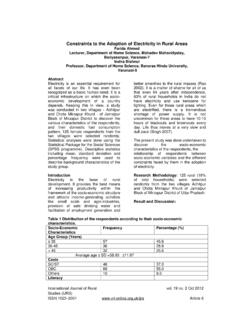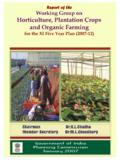Transcription of Evaluation of Kalanamak Technology - VRI
1 Evaluation of Improved Kalanamak Rice Technology : Accelerating adoption and stabilizing productivity in Eastern Uttar Pradesh * ** ** +. HN Singh , US Singh , SP Singh and RK Singh *, **Associate Professor (Corresponding Author, ID. & Professor of Agricultural Economics, respectively, ** Professor of Plant Pathology, GB Pant University of Agriculture &. Technology , Pantnagar, US Nagar 263 145 UA and + Ex-Liaison Scientist of IRRI-India Office, CG Block, NASC Complex, DPS Marg, New Delhi-110012. the advent of high yielding varieties, first the Mahsuri Uttar Pradesh has been the home of some of the and Malasia and subsequently Swarna and Samba finest quality scented rices. While the long-grained mahsuri, the farmers started fast replacing Basmati rice is grown in Western and Kalanamak , particularly because of its low and Uttranchal, the small and medium grained scented unstable yields.)
2 The critical production environment rices are distributed all over Due to the quest for (favorable rain fed lowland) that was well suited to high yielding varieties, beginning in the mid-sixties, a Kalanamak also provided an ideal situation for the large number of small and medium grained scented Mahsuri group of rice varieties. Because of yield rice varieties, slowly vanished from the farmers' advantages, the inclusion of these varieties on farms fields. For example, only a few years back, U .P. had enhanced farmers' gross income ( ). Thus the as many as 40 well-known scented rice varieties, but area under these varieties increased and Kalanamak today, one finds not more than 3 or 4. In the absence decreased.
3 The area income relationship became of any systematic breeding work and seed production negative for Kalanamak , while it was the reverse for program, most varieties found on the farmers' fields Mahsuri (Singh 2005). In farmers' fields, show a high degree of admixture, so much so that productivity ranged between to t/ha. In the the varieties are on the verge of losing their identity absence of any systematic breeding program and (Singh al. 2003). disorganized seed production (100 % farmers use their own saved seed), the level of admixtures greatly A new initiative for the improvement of non-Basmati increased, thus adversely affecting its quality. In scented rices was launched in 1997 under an IRRI- addition, a recent shift in the cropping sequence and GBPUAT collaborative program.
4 The emphasis of the crop rotation and increased use of chemicals and program was more on collection, characterization fertilizers also spoiled the quality of Kalanamak to and pure line selections of some prominent varieties some extent. Blast epidemics in two consecutive of Kalanamak , Hansraj, Tilakchandan and Tapovan years 1998 and 1999, virtually wiped out basmati. In this paper, some of the achievements on Kalanamak rice crops in this area. As a result, Kalanamak work and their Evaluation are discussed farmers drastically cut their areas of Kalanamak . in detail. Neck blast and yellow stem borers are the major pest problems in Kalanamak . The lower temperature Kalanamak rice area has declined: Kalanamak vs during flowering accentuates the neck blast Mahsuri incidence.
5 The total absence of a marketing network For ages, Kalanamak occupied a prime position for procurement, processing and sale in domestic or among the rice varieties in eastern Uttar Pradesh. Its foreign markets has been the other discouraging cultivation is localized in the Tarai area adjoining factor for Kalanamak farmers (Singh et al. 2005). Nepal particularly in the districts of Siddharthnagar, Santkabirnagar and Basti (Fig. 1) and in small Efforts towards Kalanamak improvement pockets in districts Gorakhpur, Mahrajganj, Little attempt has been made in the past to improve Balrampur, Gonda, Bahraich, Shrawasti, Deoria and Kalanamak with respect to quality and/or yield. The Padrauna (North Eastern Plain Zone of eastern UP).
6 Germ plasm of Kalanamak were collected and In eastern Uttar Pradesh, it is cooked in honor of characterized by scientists from INDUAT, Faizabad, guests and/or given as a gift. Its cooking at marriage and Benaras Hindu University, Varanasi. At is considered auspicious and its smoke is believed to Faizabad, the scientists isolated and field evaluated purify the atmosphere. No wonder its name also 14 distinct types of Kalanamak , which showed wide appears in old Indian history. variation, but none of them showed any superiority over the check. Although there is no official record, extensive discussion with farmers of its native area of In 1997, a systematic program for the improvement cultivation revealed that Kalanamak used to be the of Kalanamak was undertaken jointly by GBPUAT- most popular variety in this area until the 1970s.
7 IRRI. The team collected 41 germ plasm of Even during the 1990s, statistics show that Kalanamak from the districts of Siddharthnagar, Basti Kalanamak was grown on more than 8 % of the rice and Gorakhpur of eastern Eastern UP. The germ area in Siddharthanagar alone. However, the area plasm were purified by single plant selection (SPS). even in this district has now come down to less than and evaluated for various traits. A wide variation was 1% (Table-1). There were several factors responsible recorded for most of the traits like plant height, for the rapid decline in cultivation of this variety. With panicle length, grain shape and size and extent of International Journal of Rural Studies (IJRS) vol.
8 13 no. 1 April 2006. ISSN 1023 2001 Page 1 of 6. aroma addition including yield. 3, the coefficient of variation of improved Kalanamak was even less than that of the most stabilizing and Field performance of improved selections: promising high yielding rice variety of Samba Mahsuri Interestingly, it was found from the data that a high (CV 19%) (Singh RK et al 2005). degree of yield variations prevails among the selections when grown on farmers' fields in No wonder the area under promising selections and Siddharthanagar in 2002 and 2003. Many of these new Technology is fast increasing. Our survey selections gave yields ranging from to t/ha as showed that from about ha of improved against the average yield of t/ha for traditional Kalanamak grown by farmers in Siddharthnagar in Kalanamak in their native area of cultivation (Table- 2002, the area increased to 145 ha in 2004.)
9 This 2). Considering the high performances of two diffusion, though unrecorded, is also taking place in selections (3216 & 3131) on normal agronomic the neighboring districts of Sant Kabir Nagar, Basti, management, it was spread over more than 600 Gonda, Balrampur, Bahraich, Shrawasti, Gorakhpur, hectare in district Siddharthanagar during 2004 Mahrajganj, Deoria, Kushinagar and bordering (DDA, Agriculture). districts in Nepal. Impact of Improved Technology in enhancing Now steps should be taken to get these selections income and yield stability quickly released and promote their cultivation by In the native area of its Evaluation , farmers use two properly organizing a seed production and crop establishment methods - Biju and Kalam, a two- distribution program.
10 Tranning needs at farm level in step transplanting method. The Biju method is the seed health management and production would go a usual transplanting practice for rice the raising long way to maintaining the purity and quality of and uprooting of 25-30 day-old seedlings to be these selections. transplanted in well puddled and planked fields with 3-4 seedlings/hill. Kalam is a special method that Recommendations requires double transplanting, a practice most common for long maturing tall rice varieties, A forum such as the Indigenous Aromatic Rice especially in rain fed lowlands areas (Singh HN Export Development & Promotion Foundation needs 2005). to be established. Today such a forum exists only for Basmati viz.









